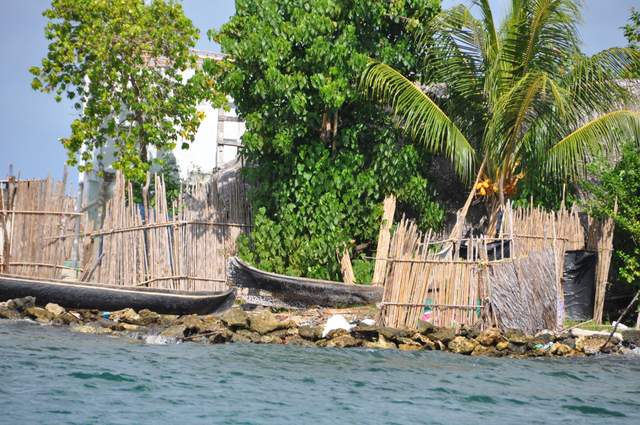It is 10:30 am and we have already done the laundry and been
to shore and back.
What we saw on San Blas Island was extraordinary. We are anchored about 75 miles off the
southeast coast of Panama, where there are 365 islands and islets scattered in
the turquoise sea that comprises the San Blas archipelago (50 of which are inhabited). We were taken back in time to grass shacks
and huts. These islands are the home to
50,000 Cuna Indians. They found refuge
in these islands after being driven from the isthmus in the 19th
century.
They fiercely defend their autonomy, language, and traditions. It is a matriarchal society where the women
run the place and the men fish and work the fields. After marriage, a man moves into his wife’s
household and baby girls are welcomed with far greater enthusiasm than
boys. Women wear elaborate traditional
dress: mola (colorful needle work
panels) blouses, skirts made of colorful printed fabrics, scarves, pearls, jeweled
combs and anklets and gold rings through their noses.
We tendered to shore and along the shoreline we saw thatched
roof huts and “parking spaces” for their boats.
This is the 21st century, and yet we could have been in an
alternate universe (except for the trash washed up on shore including plastic
bottles of all types). The maze of
narrow streets was dirt, there was no glass in the windows, and the doors were
just openings in the wooden poles that made up the walls. There were children running about – lots of
children – and all wanted to have their picture taken for “one dolla.” The people were extremely short and they all
seem to have the same facial structure (can you say inbreeding?). The women all dressed very similar and they
had a black line painted from the forehead down to the tip of the nose. Most of them were sitting in the shade on
large buckets sewing molas by hand.
There were children holding parakeets on the head, arm or stick wanting
us to take a picture for “one dolla.” There
were puppies and kittens and monkeys…
We came across the “kitchen.” This is an area where the communal food was
prepared in huge vats over a wood fire. They were cooking rice and I think mole
sauce.
There was one concrete building,
which was the school. Molas were hung
everywhere. There were so many, that I
got sensory overload and could not make a selection as I did want to buy one
for a souvenir. So what exactly is a
mola? It is a technique, sometimes
called reverse appliqué, that involves sewing several layers of different
fabrics together and cutting down through them in a pattern, something like a
contour map, turning the cut edges under and sewing them down. How did it start? The Cuna wore very little clothing and
decorated their bodies with tattoos with elaborate designs. When the missionaries came and convinced them
to wear clothes, they adapted the designs to fabric. The valuable molas are hand stitched using
bright colors and intricate patterns.
It was just unbelievable that people live like this
today. Yes, there was technology. I did see one sewing machine. There were satellite dishes and some had cell
phones. This was not the cleanest place,
either. Toilet facilities were
primitive, i.e. an outhouse suspended over the water. I peeked into some houses and saw hammocks inside,
no beds.
I am going to upload a bunch of photos. In this case, a picture is worth a thousand
words. I did not get the sense the
people were unhappy or desperate. They don’t
seem to need a lot of stuff. It was a
fascinating experience and if I was an anthropologist, I might enjoy spending
some time there to find out why they live as they do. I can see keeping your traditions, as many
other cultures do such as the Maori in New Zealand, but why live like
that?
Upon returning to the ship, Michael went to the pool and I
stayed behind to write. After lunch, we
sat in Seabourn Square, which is located on deck 7, to read (for Michael) and
to knit (for me). A woman from Bulgaria
came over to see what I was knitting and we had a wonderful discussion about
knitting related stuff, including the cockamamie way she knits. She wraps the yarn around her neck and uses
her thumb to make the stitch. It was
then on to bridge, where I had to play.
All this bridge stuff makes me tired. We put all the stuff out, play the game, and
then put all the stuff away. Now we are
making the boards (for you non-bridge players, that means shuffle the deck and
deal out the hands, which then go in a plastic carrier or board) – 22 of them!!
Dinner tonight was Japanese, which Michael really wanted to
do. I want to have a peanut butter and
jelly sandwich. He won. Tomorrow, I win. I really dislike having to dress for dinner
-- having to change my clothes, shoes and earrings three times a day. And this is only day eight [sigh].








Those colorful things are pretty! Don't know how you'd pick only one. Things back here are COLD. Into the 20s at night. Car dealer hasn't gotten back with me yet. They are afraid, lol...
ReplyDeleteThe molas you saw were beautiful very intricate compared to what I saw in Panama I hope you bought several. The ones in Panama were not more than a few fabrics minimal design and were expensive how much did they cost there on the island curiosities killing me?
ReplyDeleteIf you just bought them and put them away for your granddaughter by the time she's a young lady they will be extremely valuable because people just won't be doing that type of work then seamstresses that see these would go crazy
ReplyDelete